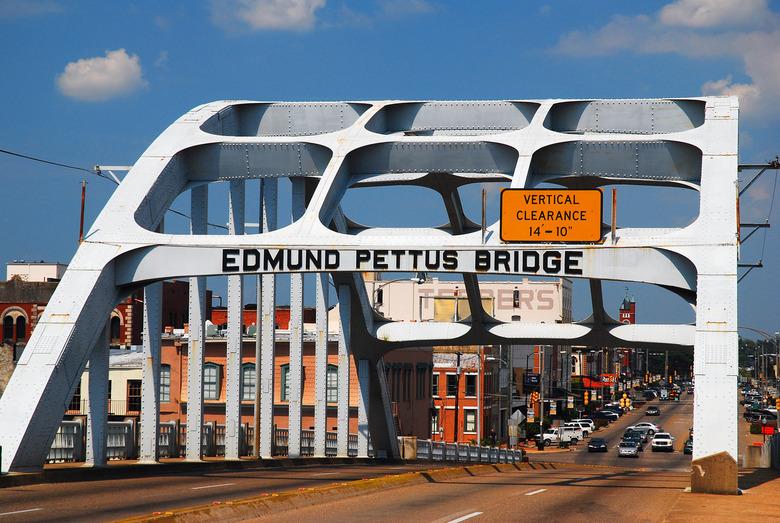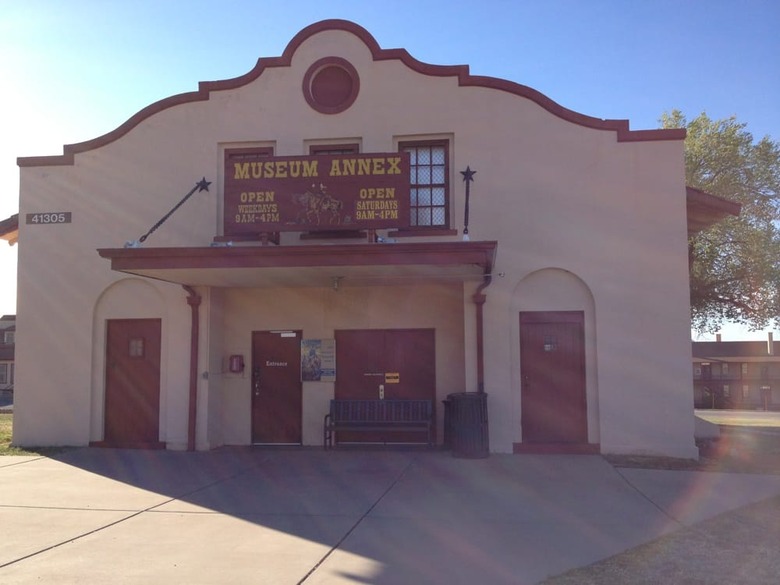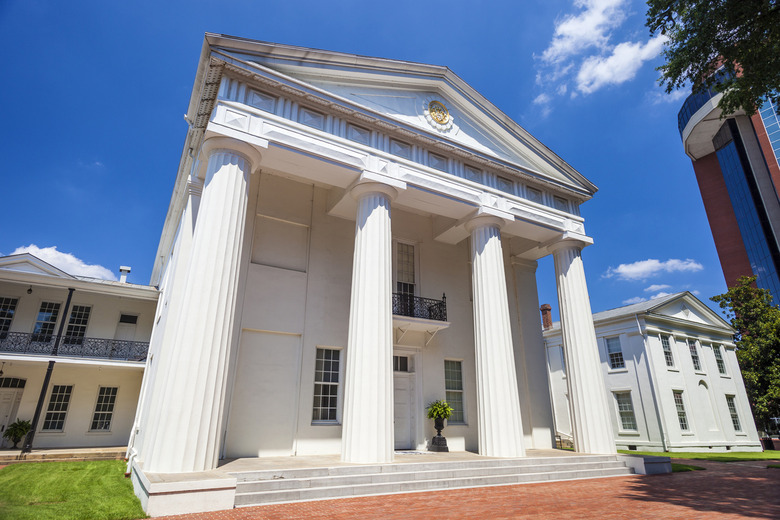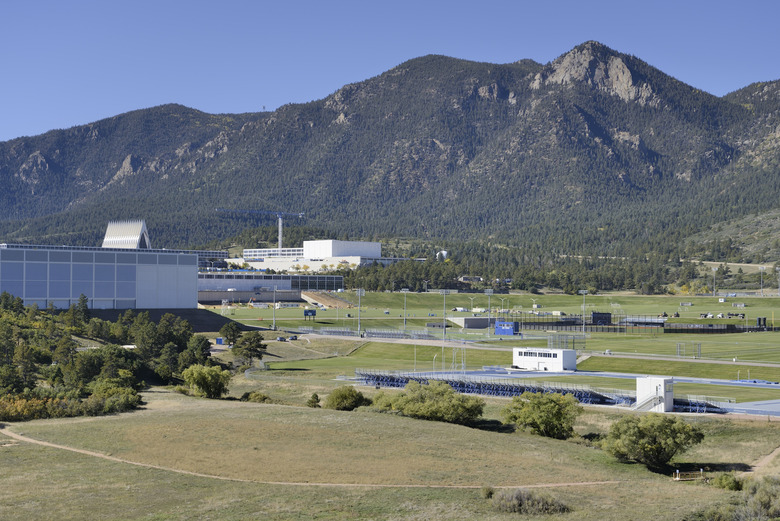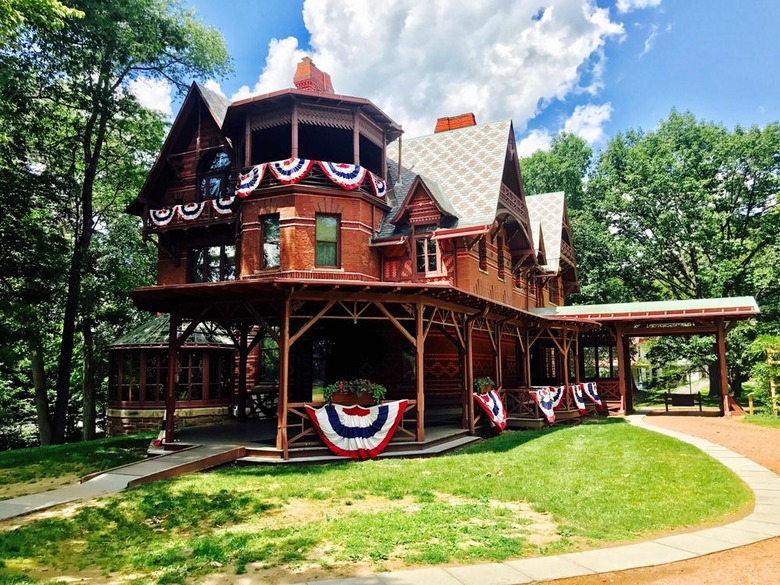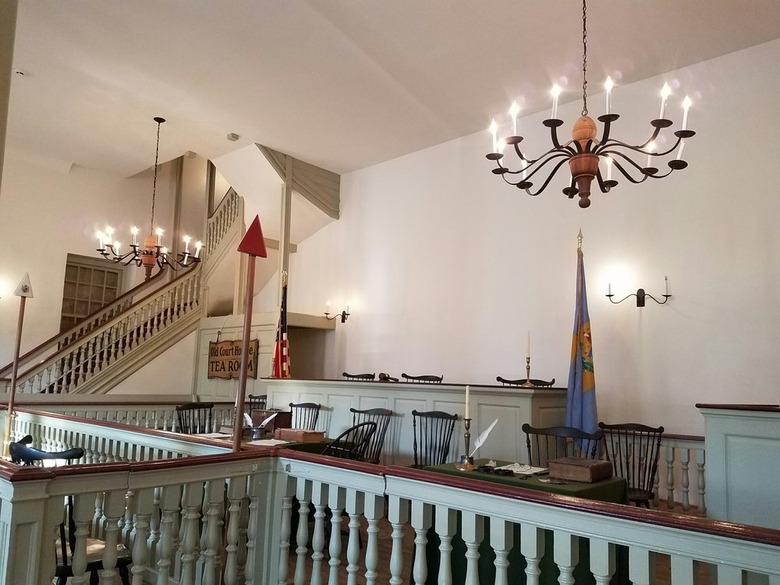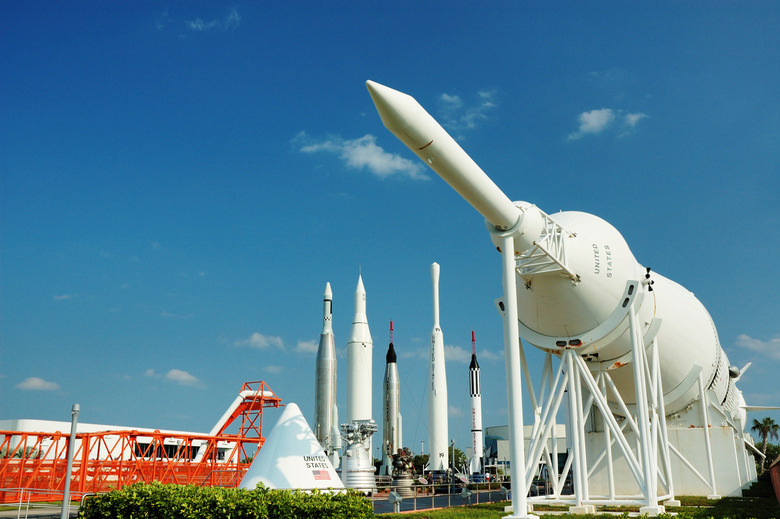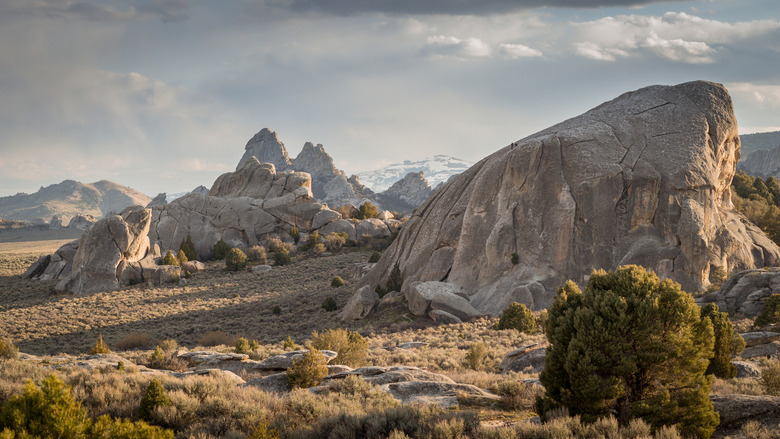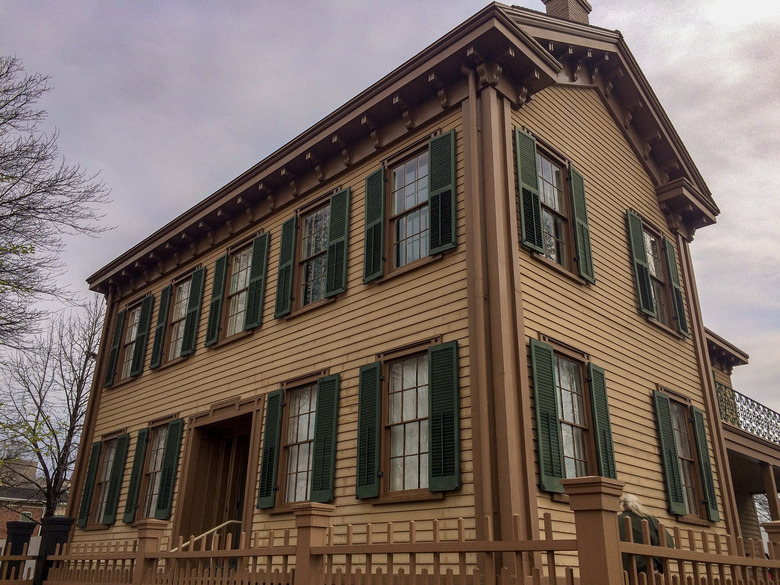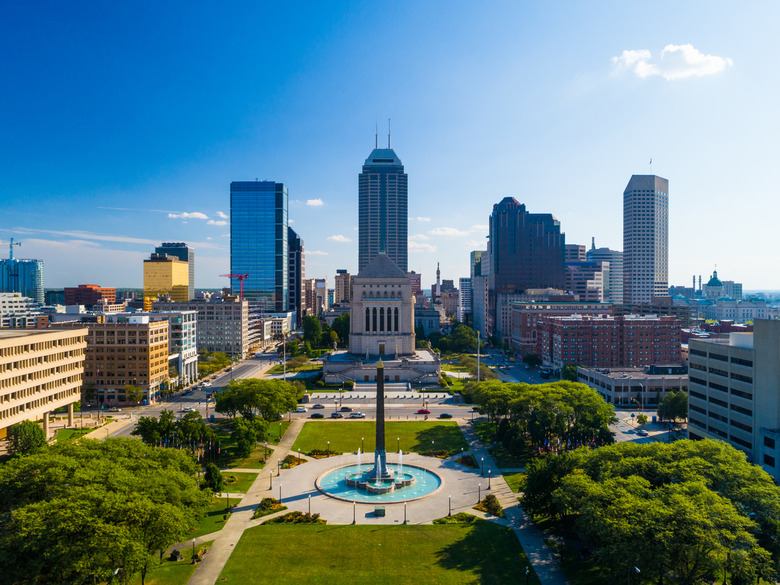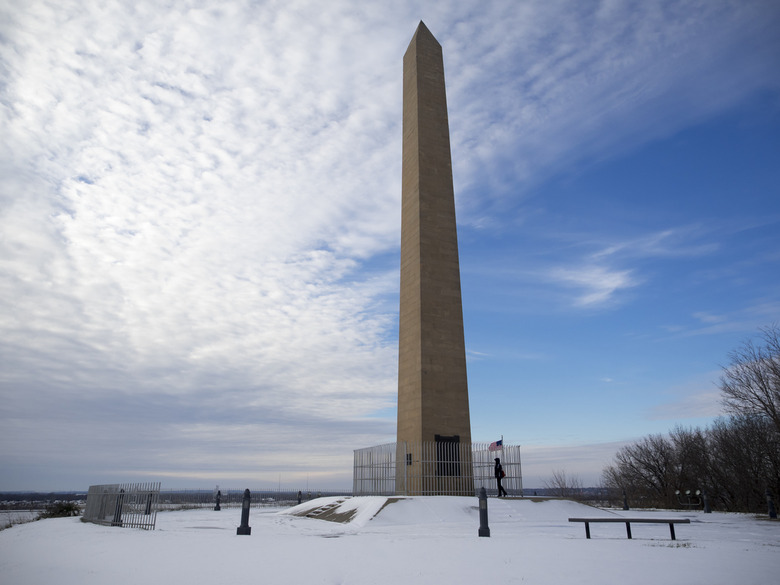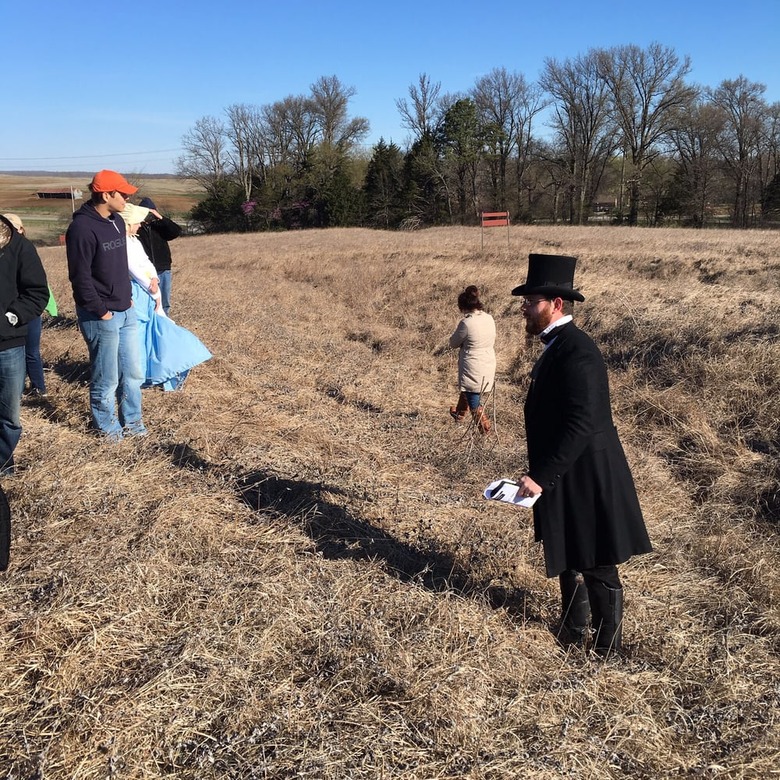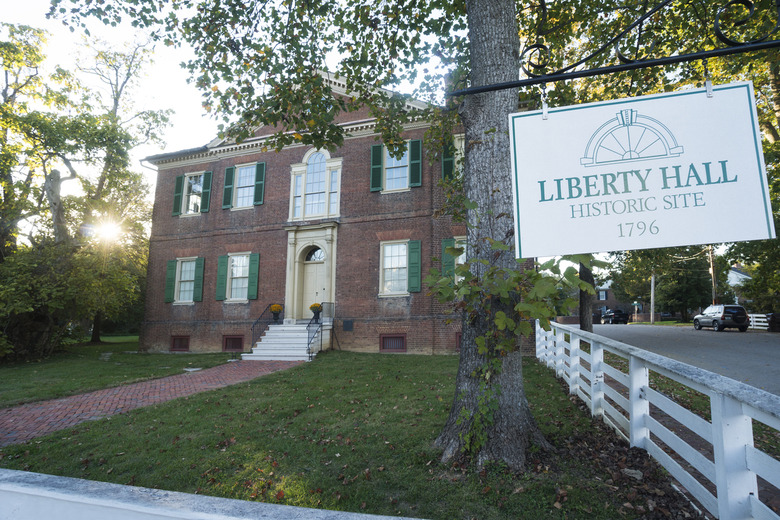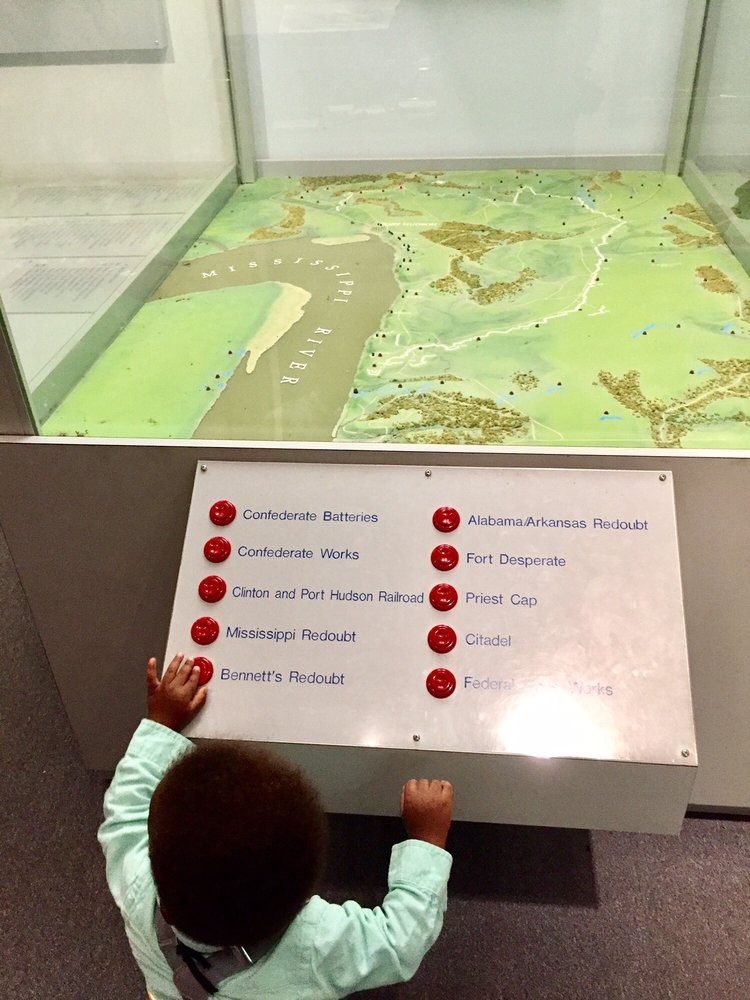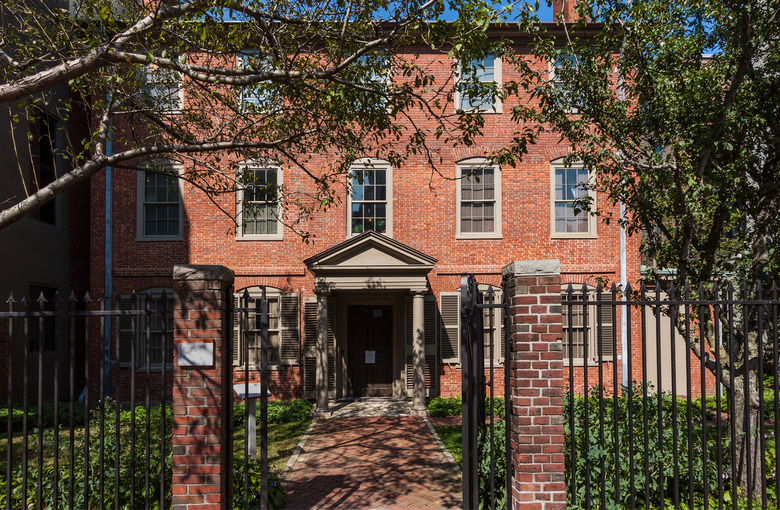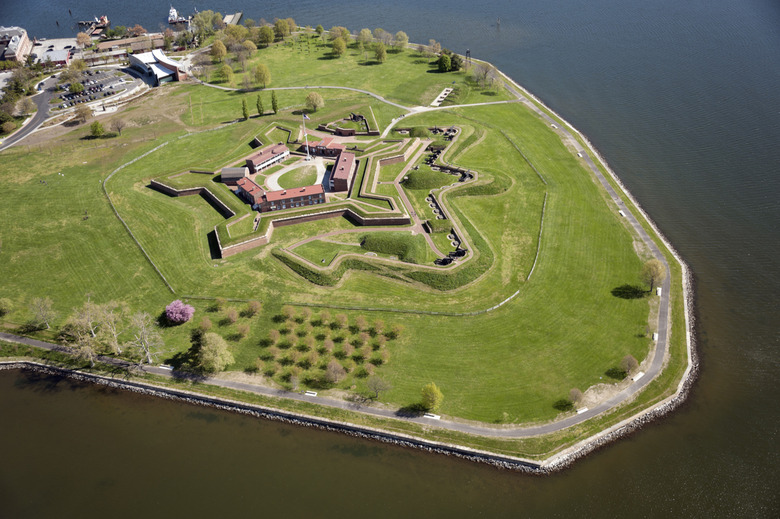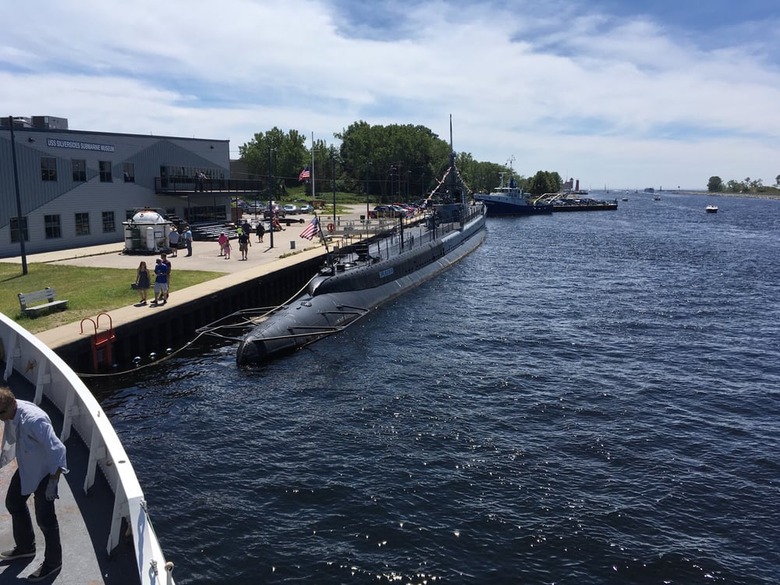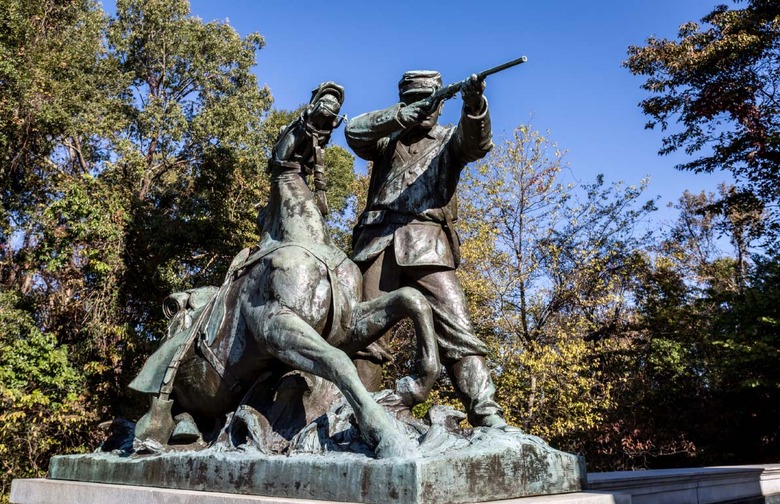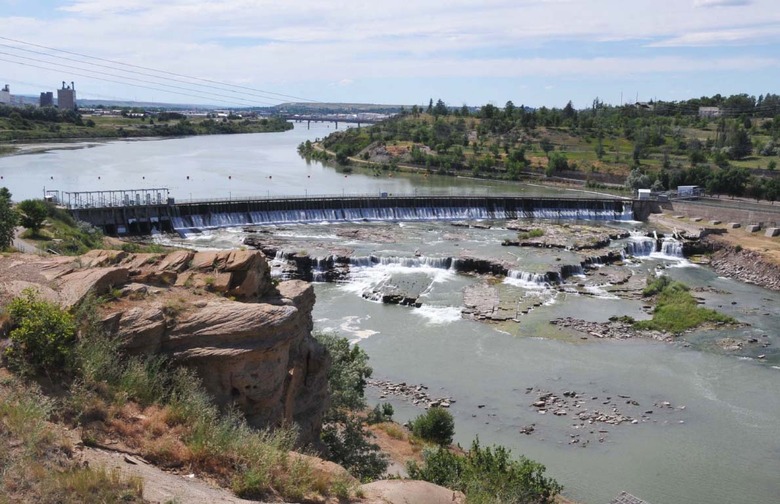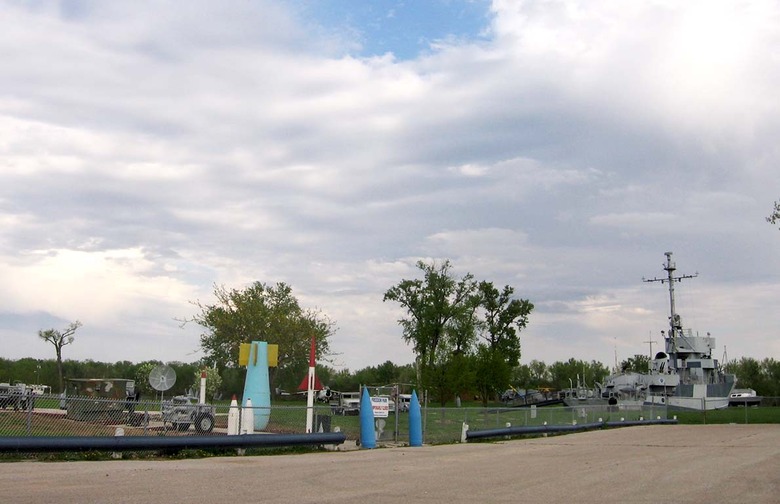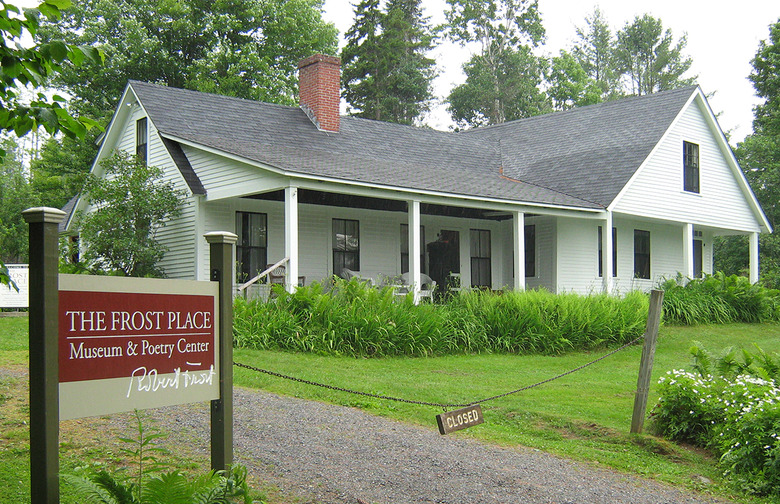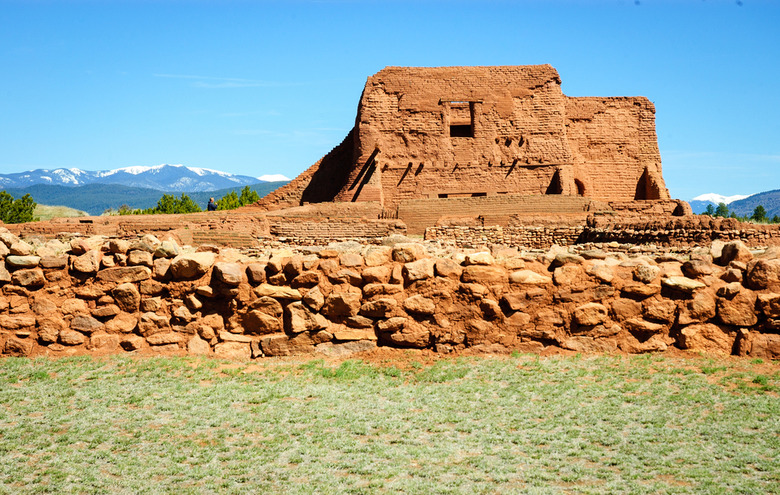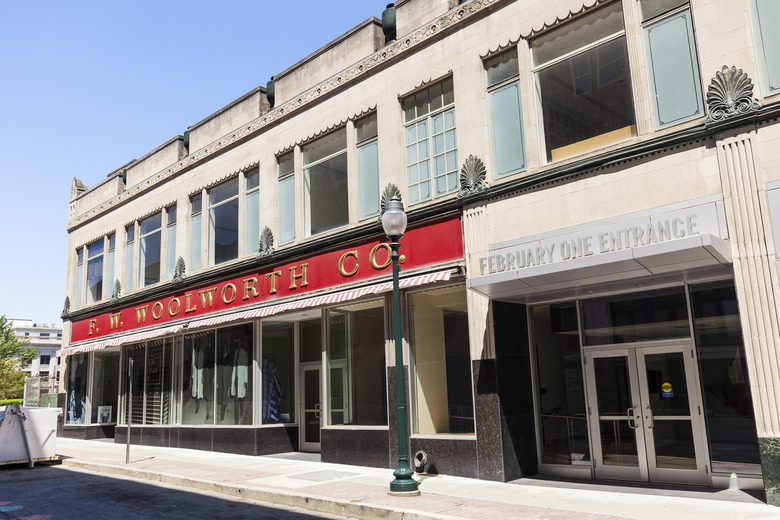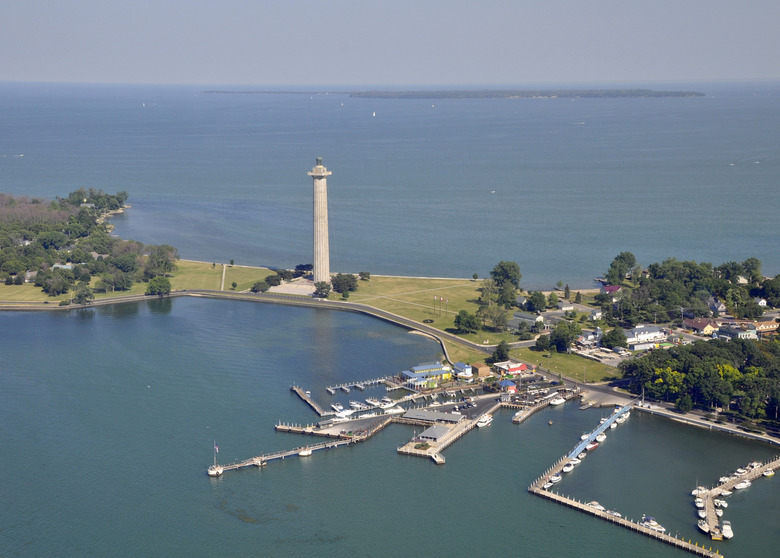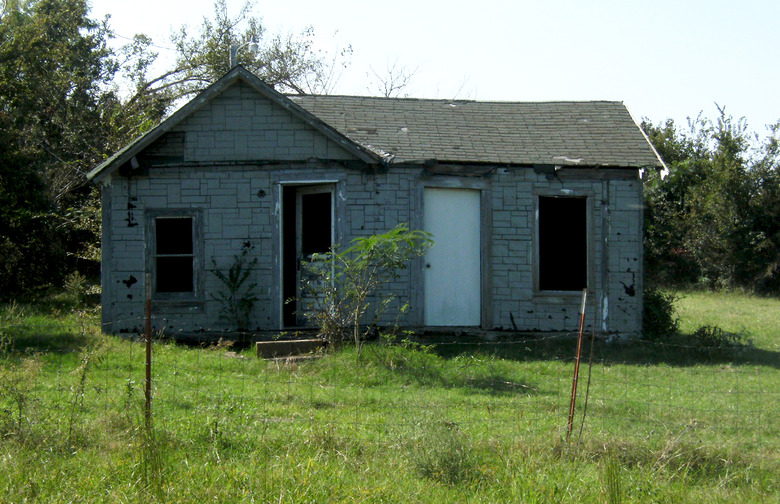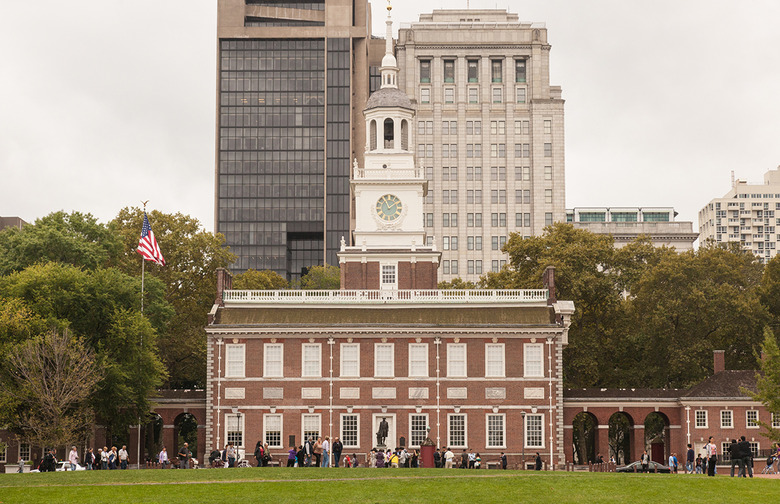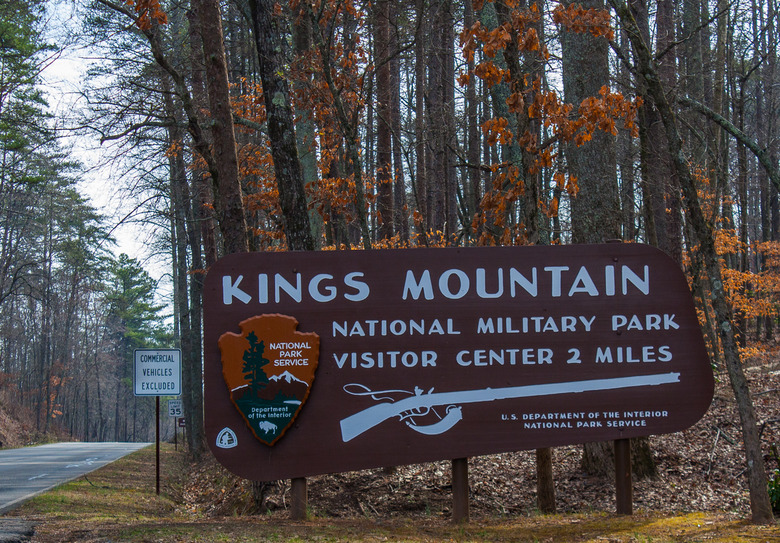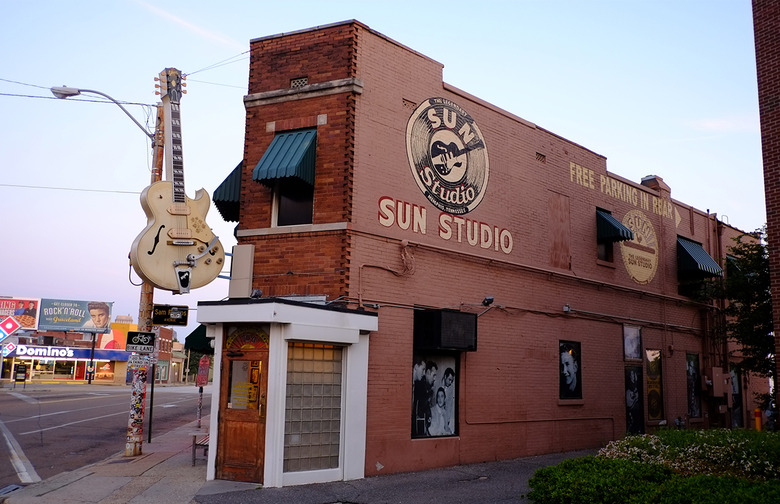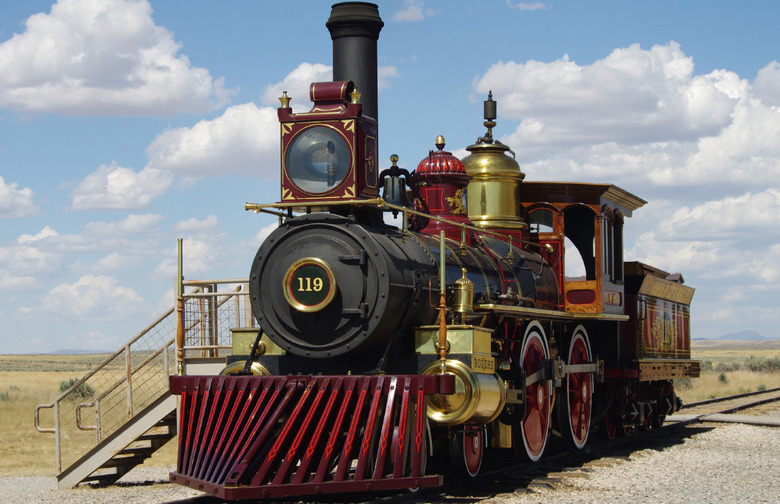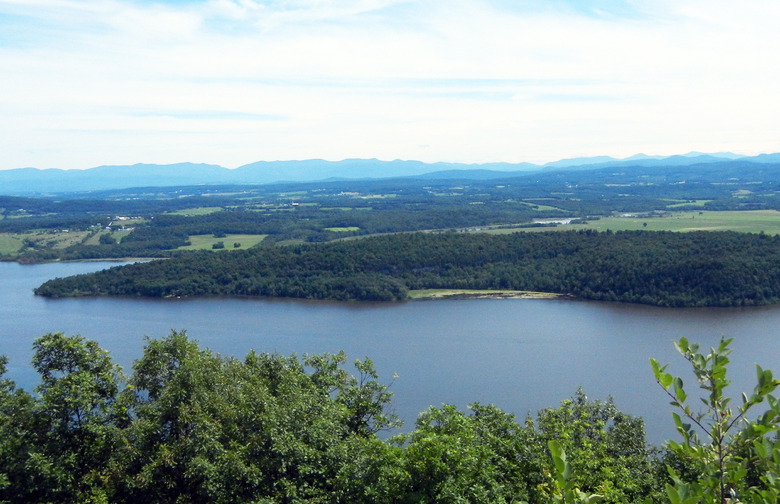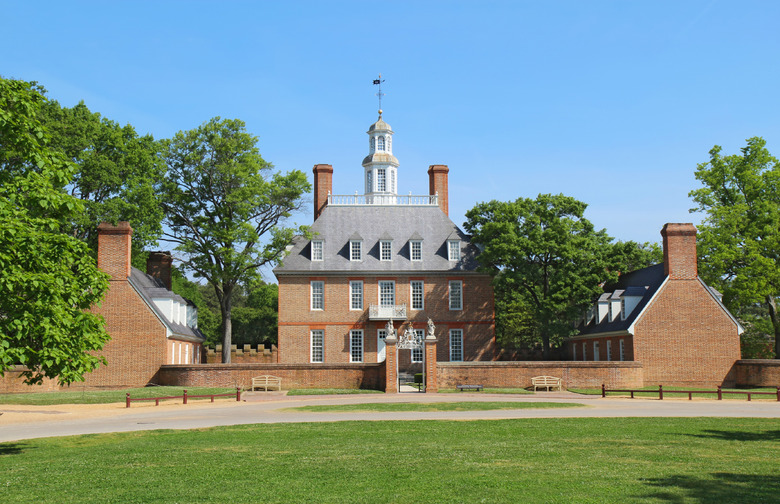The Most Patriotic Destination In Every State Gallery
The Fourth of July is a time when many Americans not only take a break, but also reflect on the great pride they feel for their country. This holiday can be the perfect opportunity to combine a feeling of patriotism with a well-deserved day trip or long weekend. The United States is immense, and full of many incredible destinations and natural wonders that would fill anyone with a great sense of pride. Some locations that make people think of America — say, the National Baseball Hall of Fame in Cooperstown, New York, or the World of Coca-Cola in Atlanta — are vivid symbols of our nation, but don't actually hold patriotic significance. As we compiled this list, we looked for places that are historically significant and also make people feel patriotic themselves while visiting.
Because of this, not all the locations in this gallery are obvious. They might be underappreciated (but meaningful) locations that deserve a bit more attention. Then again, others are very popular, and can even be a bit cliché — which is perfectly fine, too!
As far as which location in each state is the most patriotic, that can get a bit tricky, because each state has numerous worthy entries. So hit the road and decide for yourself! Use this list as a travel guide to explore 50 of the most can't-miss destinations across America, and a solid starting point for a patriotic journey around this great land.
Alabama — Selma to Montgomery National Historic Trail
The Declaration of Independence states, as the first of the truths the Founding Fathers held to be self-evident, that "all men are created equal." Although Thomas Jefferson and Benjamin Franklin wrote these words more than 240 years ago, most agree that the new country didn't quite reflect that ideal. Even today, whether we truly have equality is questioned, but there's no doubt we as a nation have come a long way. The civil rights movement was a massive part of this, and some of the most important individual events were the three marches in Alabama in March of 1965, when Dr. Martin Luther King Jr. and thousands of supporters made the 54-mile journey from Selma to the Alabama state capital of Montgomery to fight for African-American citizens' right to vote. It is now recognized as the Selma to Montgomery National Historic Trail in Alabama, part of the National Park Service, which operates centers in Selma and Lowndes County in commemoration of the marches.
Alaska — Klondike Gold Rush National Historical Park
America's 49th state has only been a state since 1959, but it still has a rich history and boasts a whopping 50 U.S. National Historic Landmarks. As much as we'd like to choose destinations like the islands of Attu and Kiska — both significant in the fight against Japan during World War II — there is very little left there, the location is extremely remote, and the weather can be harsh and dangerous. Instead, we opted for the Klondike Gold Rush National Historical Park, which commemorates the migration of an estimated 100,000 prospectors looking for their piece of the American Dream. Tourists can take ranger-led walking tours of the Skagway Historic District, ascend the 2,865 feet to White Pass via the White Pass & Yukon Route Railway, explore the museum and visitor center for the Gold Rush's 33-mile Chilkoot Trail, or even hike the route themselves.
Arizona — Fort Huachuca
Although Fort Huachuca in Arizona was originally built to combat the Chiricahua Apache tribe and secure the border with Mexico, the fort made its patriotic mark in 1913 when the base became home to the "Buffalo Soldiers" of the 10th Cavalry Regiment, which was established in 1866 as a unit consisting entirely of African-Americans. Fort Huachuca later housed 1,251 officers and 24,427 enlisted soldiers during World War II and became a U.S. Air Force base during the Korean War. Still an important base, training site, and medical center, the fort has been a National Historic Landmark since 1976 and houses two museums — with a special emphasis on the Buffalo Soldiers — which are open to all visitors (military and civilian) free of charge (although a donation is suggested).
Arkansas — Old State House
We almost gave this spot to the USS Hoga tugboat — which played a crucial defensive role during the attack on Pearl Harbor and which is now stationed in Arkansas — but decided to go with something with a bit more Arkansas-related history. The Old State House was built in the 1830s and is the oldest surviving state capitol building west of the Mississippi River. It was once home to both houses of the state's General Assembly, and was the site of a fatal knife fight between legislators in the House of Representatives in 1837. Union troops used the State House while occupying Little Rock during the Civil War, and it once served as the Arkansas War Memorial and was a meeting place for patriotic organizations. It became a museum in 1947 — which it still functions as today — showcasing exhibits related to the state's history and culture. Admission is free.
California — Rosie the Riveter WWII Home Front
We've focused on a lot on the actions of military and political figures during wartime, but what about all the ordinary people who helped out? Enter the Rosie the Riveter WWII Home Front National Historical Park in California. There's a lot to see here (and it's all free!), but you'll definitely want to check out the extremely informative Visitor Education Center, the Rosie the Riveter Memorial, the SS Red Oak Victory Ship.
Colorado — US Air Force Academy
Home to over 4,000 cadets, the U.S. Air Force Academy celebrates its 64th anniversary in 2018, and is easily the most patriotic location in Colorado. Visitors can check out scenic views of the Honor Court, Arnold Hall, Cadet Field House, and Falcon Athletic Center from overlooks, or visit the Cadet Chapel (and its stunning architecture), Visitor Center, Falcon Stadium, and Association of Graduates Building. When school is in session, seeing the entire student body in noon mealtime formation will certainly fill observers with national pride. Not too far from the Academy in Colorado Springs is another site where strong young Americans are trained for future "battle" against other countries: the United States Olympic Training Center.
Connecticut — Mark Twain House and Museum
Patriotism isn't just about wars and politics; it includes love for all aspects of one's country. With that in mind, we selected an important literary site for Connecticut, the home of Mark Twain, one of the greatest writers in American history. Although Twain was born in Missouri (as Samuel Langhorne Clemens), he lived with his family in this Hartford home between 1874 and 1891. Even though it was only a 17-year residency, in that time Twain penned The Adventures of Tom Sawyer, The Prince and the Pauper, Life on the Mississippi, Adventures of Huckleberry Finn, A Tramp Abroad, and A Connecticut Yankee in King Arthur's Court. The house has served as a museum since 1974 (along with an additional 45,000-square-foot building that opened in 2003).
Delaware — First State National Historical Park
What better way to celebrate patriotism in America's first state than a visit to First State National Historical Park? Although it was only created in 2013, the park was a much-needed way to group together numerous historically-significant sites in the region, including the First State National Monument, The Green (the site where Delaware voted to ratify the U.S. Constitution), and the New Castle Court House Museum, where New Castle, Kent, and Sussex Counties first declared their independence and created the state of Delaware.
Florida — Cape Canaveral Air Force Station
Say what you will about America's current scientific standing in the world, but we're still the all-time best at launching stuff into space. Cape Canaveral Air Force Station in Florida was built in 1940 and was the famed launch site of the first U.S. Earth satellite (1958), first U.S. astronaut (1961), first U.S. astronaut in orbit (1962), first two-man U.S. spacecraft (1965), first U.S. unmanned lunar landing (1966), and first three-man U.S. spacecraft (1968). It was also the launch site for all of the first spacecraft to (separately) fly past each of the planets in the solar system (1962–1977), the first spacecraft to orbit Mars (1971) and first to roam its surface (1996), the first American spacecraft to orbit and land on Venus (1978), the first spacecraft to orbit Saturn (2004), and to orbit Mercury (2011), and the first spacecraft to leave the Solar System (1977). These make a decision to vist the station, Kennedy Space Center, and the Space & Missile Museum a simple calculation. Come on, it's not rocket science!
Georgia — Stephen Heard Cemetery
Georgia used to be home to the National Museum of Patriotism, but it unfortunately closed in 2010, so the torch must be passed. The state has a lot of important locations and figures from history worthy of recognition, but two patriots are especially deserving of this spot. Stephen Heard was a veteran of the French and Indian War, friend of George Washington, and a hero of the American Revolution as a lieutenant colonel. Heard was captured at the Battle of Kettle Creek in 1779, but he was rescued by one of his slaves, named Kate, and went on to become Governor of Georgia. Both he and Kate are both interred at Stephen Heard Cemetery (also called Gods Acre Cemetery) in Elberton, Georgia.
Hawaii — U.S.S. Arizona
On December 7, 1941, Japan launched a surprise attack on the United States Naval Station at Pearl Harbor, Hawaii, killing 2,403 Americans and wounding 1,178 others. Over 1,000 of those fatalities occurred when the U.S.S. Arizona was blown up and sank, and a memorial was built in 1962 to honor the fallen. The site has been visited by every U.S. president since the ship's destruction, and the hull can still be seen resting below the surface. Eerily, visitors can also still see oil leaking from the wreckage on the surface of the water, which is sometimes referred to as "the tears of the Arizona." The memorial is part of the National Park Service's World War II Valor in the Pacific National Monument, and is only accessible via ferry. Entry to the Pearl Harbor Visitor Center and tickets to the U.S.S. Arizona Memorial are both free, but only 1,300 are handed out per day on a first-come, first-served basis.
Idaho — City of Rocks National Reserve
In the middle of the nineteenth century, over 400,000 settlers traveled through harsh and dangerous terrain on the 2,000-mile-long California Trail from the Missouri River to the West Coast looking for better lives for themselves and their families, paving the way for future generations of Americans. Many passed through what is now the City of Rocks National Reserve in southern Idaho (also known as the Silent City of Rocks), and some carved or wrote their names in axle grease on rocks in the area — specifically "Register Rock" — and these names can still be seen today, almost 200 years later.
Illinois — Lincoln Home National Historic Site
Picking the most patriotic destination in Illinois was as easy as flipping a coin. Not in the traditional way, but because if you flip a newer quarter over to the tails side, you'll see an image of the former president and the words "Land of Lincoln." Although Abraham Lincoln grew up in Kentucky and Indiana, his family moved to Illinois when he was 21, and the only house he ever owned was in Springfield, where he lived from 1844 until he was elected president in 1861. After his assassination, Lincoln was buried in Springfield's Oak Ridge Cemetery. His house, along with several other structures within a four-block radius (now owned by the National Park Service), has been restored to its appearance during the time in which Lincoln resided there. There is no entrance fee, but only a limited number of tickets are distributed per day, on a first-come, first-served basis.
Indiana — Indiana World War Memorial Plaza
Before any Lincoln-lovers point out that we should have picked the Lincoln Boyhood National Memorial for Indiana's entry, we'd like to remind everyone that the house on the site is only a replica built in 1945. Although it's still very impressive, we're giving the nod here to the Indiana World War Memorial Plaza. Located in Indianapolis, the site was first built in 1926 as a WWI monument, and also in an attempt to showcase the state's patriotism and lure the newly formed American Legion away from New York City. It worked, and the site was expanded to include a WWII memorial as well. In total, the plaza includes a 210-foot-tall main building (based on the Mausoleum of Mausolus in Turkey and built out of Indiana limestone), which houses a very impressive military museum, as well as the aforementioned American Legion headquarters, a cenotaph square, and the Veterans Memorial Plaza, which includes an obelisk and numerous fountains.
Iowa — Sergeant Floyd Monument (and Towboat)
Even though Charles Floyd — an explorer who was the only person to die on the Lewis and Clark Expedition — was a native of Kentucky, he gets a lot of love in Iowa, his final resting place. Sioux City is not only home to the Sergeant Floyd museum boat (one of only three surviving steam-powered towboats in the U.S.; free admission), but also the Sergeant Floyd Monument at Floyd's Bluff on the Missouri River. This obelisk and National Historic Landmark was built in 1901 and sits on a 23-acre park with beautiful views of the river valley, and is not too far from Floyd's burial site. It serves as a significant reminder of the extraordinary sacrifices ordinary people made in the early years of American history.
Kansas — Black Jack Battlefield and Nature Park
Although another famous battle is generally regarded as the first of the Civil War (more on that later), some believe the Battle of Black Jack in Palmyra Township, Kansas, was the true beginning. After noted abolitionist John Brown's two sons were captured by pro-slavery forces, Brown and 29 others faced off against Henry C. Pate and his men on June 2, 1856. The five-hour battle resulted in a victory for Brown, who managed to capture Pate and 22 of his followers. They were released in exchange for Brown's sons. Although the war wouldn't officially begin for another five years, this battle showed the lengths determined and principled American citizens were willing to go to fight for freedom. The battlefield was designated as a National Historic Landmark in 2012, and patriotic tourists are free to visit from dawn to dusk daily.
Kentucky — Liberty Hall
A different John Brown — this one a slaveholder rather than a firebrand abolitionist — was one of the most important early statesmen in Kentucky. In 1796, Senator Brown built Liberty Hall, a two-story home in Frankfort where he lived until his death in 1837. Since then, the house has seen numerous other notable residents, including two other U.S. senators, one vice-presidential candidate, one governor of Missouri, one commissioner of the Bureau of Indian Affairs, one ambassador to France, and three U.S. Army colonels. Today it is a museum exploring the history, politics, and social and cultural life in early Kentucky through the homes, gardens, documents, and artifacts of Senator Brown and his family.
Louisiana — Port Hudson State Historic Site
Lasting for 48 grueling days in 1863, the Siege of Port Hudson in Louisiana was the final engagement in the Union campaign to recapture the Mississippi River during the Civil War. Northern forces struggled to capture the fort, but Confederate general Franklin Gardner eventually surrendered after learning of the fall of Vicksburg, Mississippi, to the Union. Port Hudson was also the first place where African-American military units fought for the Union Army under African-American field leadership. The site was designated as a National Historic Landmark in 1974 and now includes a museum about the siege, artillery displays, and numerous informative and commemorative plaques.
Maine — Wadsworth-Longfellow House
This house, built in 1785, holds three important distinctions. First, it was the earliest wholly brick dwelling in all of Portland, Maine. Second, it was built by Revolutionary War General Peleg Wadsworth. And third, it was the childhood home of poet Henry Wadsworth Longfellow (Peleg's grandson), and his residence for 35 years. This site is significant for both American military and literary reasons, and when Anne Longfellow Pierce (1810-1901) died, she left the house to the Maine Historical Society. With virtually all of the household items and artifacts original to the Wadsworth and Longfellow families, it (and the attached Longfellow garden) became a National Historic Landmark in 1962. Admission is $15, but the garden is free and open to the public Monday through Saturday from May through October.
Maryland — Fort McHenry
Fort McHenry in Baltimore is a star-shaped fort most famous for defending Baltimore Harbor from a British Navy attack during the war of 1812. Francis Scott Key was witness to the event, and it inspired him to write a poem that later became the United States' national anthem. You can't get much more patriotic than that! Today, the site is a National Monument and Historic Shrine, and it draws thousands of visitors every year — especially on Defender's Day, September 12, when programs, fireworks, and other events are scheduled in remembrance of the aforementioned Battle of Baltimore. Among other historic artifacts, the original flag featured in the Star Spangled Banner is on display at the fort. Entrance is $10, but children under 15 are free.
Massachusetts — Bunker Hill
Boston, Massachusetts, is so chock-full of history that picking one site is sure to infuriate history buffs no matter what. But we have to go with Bunker Hill and its 221-foot-tall obelisk monument. Not only was it the site of the first major battle of the American Revolution on June 17, 1775, but it was the source of the famous quote: "Don't fire until you see the whites of their eyes." Although the ill-prepared colonial forces eventually retreated, they managed to kill or wound almost half of the British soldiers present. In the end, it was a valuable lesson: Just because you lose a battle, doesn't mean you'll lose the war. A visit to the Bunker Hill Monument is free, even if you wish to climb the 294 steps all the way to the top — which is absolutely worth it for the sweeping city views.
Michigan — U.S.S. Silversides
Ask people where the most decorated U.S. submarine still in existence is currently located, and few people would guess that it's currently in Muskegon, Michigan. Having sunk a confirmed total of 23 ships during World War II and awarded 12 battle stars and a Presidential Unit Citation, the U.S.S. Silversides is now retired and resting as the centerpiece of its own namesake museum. Along with the Prohibition-era U.S. Coast Guard cutter McLane, the vessel is open year round for public tours and even overnight encampments.
Minnesota — Charles A. Lindbergh State Park
As we explained in the entry for Florida, America has basically owned the skies for the last 100 years. It's only fitting that we would choose Charles A. Lindbergh State Park as the patriotic site for Minnesota, as it not only was once the farm of namesake Congressman Charles August Lindbergh, but also his son, Charles Lindbergh, the first man to successfully complete a solo nonstop flight from New York to Paris. Although it's definitely worth mentioning that the younger Lindy expressed some terrible opinions on race and geopolitics, his 1927 feat nevertheless stands as an impressive accomplishment. This state park on the outskirts of Little Falls is now open to public, offering both a chance to explore the house itself, as well as providing 38 campground sites. You don't have take your trip solo like Lindberg, especially since one of the campsites is capable of accommodating 30 people!
Mississippi — Vicksburg National Military Park
Vicksburg National Cemetery in Mississippi is one of the largest military burial sites in America, second only to Arlington National Cemetery in Virginia. Out of the 17,000 Union soldiers whose remains are interred there, 75 percent are listed as unknowns — which is all the more reason to visit and pay tribute to these anonymous heroes. Vicksburg was the first national cemetery established by Congress, and the surrounding national military park also memorializes the Battle of Vicksburg, waged from May 18 to July 4, 1863, which was one of the most crucial Union victories of the Civil War. Entrance fees are $20 per vehicle, and tours are available through numerous non-NPS companies.
Missouri — The Gateway Arch
Although we're tempted to select Anheuser-Busch Brewery as the most patriotic place in Missouri, we know a few St. Louis folks who would be quite upset if the Gateway Arch didn't take this spot — and for good reason! After all, the arch isn't just a neat landmark to climb; it's part of the Jefferson National Expansion Memorial, which commemorates the Louisiana Purchase (and the starting point of the Lewis and Clark Expedition), the first civil government west of the Mississippi River, and the debate over slavery exacerbated by the infamous Dred Scott case. The "Journey to the Top" costs $13 (including a documentary screening), but entrance to the 91-acre park will only run you three bucks.
Montana — Great Falls Portage
The Lewis and Clark expedition passed through Montana on their way to the Pacific, and one of the biggest challenges for the expedition came on the Missouri River in the area now known as the Great Falls Portage. The team carried their boats overland for 31 brutal days to make the 18-mile portage, and two separate portions of this route are now recognized as national historic landmarks. Further illustrating the location's significance, the Great Falls Portage was named by the National Trust for Historic Preservation as one of America's most endangered places in 2008.
Nebraska — Freedom Park
How could we leave a place like Freedom Park in East Omaha, Nebraska, off this list? Not only is the name perfect, but the park is filled with decommissioned military aircraft and artillery pieces, including its two major exhibits: the World War II minesweeper U.S.S. Hazard (also a national historic landmark) and Cold War-era submarine U.S.S. Marlin. The park is absolutely free to enter, and special tours — also free — are offered on weekends in the warmer months.
Nevada — Hoover Dam
The Hoover Dam didn't make this list just for being a big tourist destination (otherwise we would have simply gone with Las Vegas), but instead because it perfectly showcases American ingenuity. When the dam opened back in 1935, it was both the largest hydroelectric power-producing facility and the largest concrete structure in the world. Staring at this unbelievably large feat of engineering really fills most visitors with pride. Plus, the dam gets bonus points for being named after a president — even though Hoover was not invited to (nor was he mentioned at) the dedication ceremony due to his perceived role in the Great Depression.
New Hampshire — The Frost Place
Robert Frost was more than just a great American poet, he was an artistic institution. His works epitomized American rural life and he was an expert on American colloquial speech. In his lifetime, he was awarded the Congressional Gold Medal and also named Poet laureate of Vermont. However, Frost actually spent most of his life in New Hampshire. In addition to his 11 years at the Robert Frost Farm in Derry (now a historic house museum and state park), the poet also lived part- and full-time at The Frost Place in Franconia. Now a museum and nonprofit educational center, the house presents a resident poet award to an emerging American poet every year, which includes a stipend and the opportunity to live and write in the house during the summer. Entrance to the house costs $5.
New Jersey — Washington’s Crossing
New Jersey is absolutely packed with Revolutionary War history, from the Ford Mansion (which General Washington used as a headquarters in 1779 and 1780) to the entire Morristown National Historical Park (which commemorates the site of the Continental Army's frigid winter encampment during the same time period). However, nothing gives us that true patriotic feeling like visiting the iconic site where Washington and 2,400 of his men crossed the Delaware River on Christmas night in 1776 as part of a surprise attack. Although the visitor center museum and Washington Crossing State Park are worth exploring — especially on Christmas Day every year, when a speech and reenactment of the crossing takes place — it's humbling to simply stand on the shore and picture the events that transpired there, which led to a victory in Trenton that lifted American morale at a difficult time for the Revolution.
New Mexico — Glorieta Pass Battlefield
The Civil War Sites Advisory Commission rated the Battle of Glorietta Pass in New Mexico to be of highest significance in 1993, placing it alongside engagements at famous places like Gettysburg and Antietam. In 1862, Confederate forces moved to capture New Mexico with the long-term goal of splitting Colorado and California from the Union. After a grueling march from Colorado, U.S. troops fought the invasion to a standstill at Glorietta Pass; meanwhile, New Mexico volunteers led the destruction of the Confederate supply train, forcing the invasion to be abandoned and ending the Confederate threat in the Far West. Sections of the battlefield have since became part of Pecos National Historic Park, but these still only comprise about 20 percent of the total battlefield; the remaining 80 is now located on private land.
New York — The Statue of Liberty
With great respect to the beautiful new 9/11 Memorial Museum at One World Trade Center, we decided to go with a classic here. Although the construction of the Statue of Liberty is significant historically, the structure's symbolism is what truly makes the destination patriotic. Completed in 1886, the statue was one of the first sights seen by hopeful immigrants entering America at the turn of the twentieth century, and the name and image have both become synonymous with America, freedom, and patriotism. Looking to visit? Unless you have your heart set on climbing to the top ($21.50), we'd recommend skipping a visit to Liberty Island altogether, as $18.50 of that fee is just for the ferry ride alone. Instead, take the Staten Island Ferry around the harbor, which features fantastic views of the statue, Ellis Island, and the Manhattan skyline — all for free. Also, if you're feeling thirsty, the Staten Island Ferry sells some of the cheapest beers in all of New York City. America, right?
North Carolina — International Civil Rights Center and Museum
The International Civil Rights Center and Museum, established in 1993, occupies the building in which civil rights protesters staged the catalytic Greensboro sit-in. Four students from historically black North Carolina A&T University sat at the segregated lunch counter at a Woolworth's store, and when they were refused service based on their skin, they simply refused to leave. Within days, the sit-in grew to include hundreds of people, earned a "deeply sympathetic" statement from President Eisenhower, and inspired similar protests in other cities nationwide with an estimated 70,000 participants in total. The present-day museum presents exhibits about the civil rights movement and preserves the historic building.
North Dakota — Theodore Roosevelt National Park
Theodore Roosevelt National Park isn't on this list just for being a scenic park — there are a ton of those already. And it's not just for the name either. This park makes the list because the badlands of North Dakota was the place where the New York native Roosevelt first fell in love with the rugged, outdoors-y lifestyle possible in America, and it inspired him to become a lifelong naturalist. In addition to buying ranches for himself, Roosevelt also established the United States Forest Service and signed into law the creation of five national parks and 150 national forests, setting aside more land than all of his predecessors combined. Admission to his namesake park costs $30 per vehicle.
Ohio — Put-in-Bay
Put-in-Bay, on South Bass Island in Lake Erie, was the site of a pivotal naval battle in the War of 1812. Nine U.S. Navy vessels under Oliver Hazard Perry defeated and captured a British force, establishing U.S. control of the lake and enabling American forces to retake Detroit. Today, the island hosts the Perry's Victory and International Peace Memorial, which celebrates the current friendship between the U.S., Canada, and Great Britain, as well as other historical sites. Put-in-Bay is also a longstanding summer tourist destination packed with fun bars and restaurants, and the island once had one of the world's largest hotels, Hotel Victory, the ruins of which can still be seen today.
packed with fun bars and restaurants, and the island once had one of the world's largest hotels, Hotel Victory, the ruins of which can still be seen today.
Oklahoma — Honey Springs Battlefield
The 1863 Battle of Honey Springs was the largest confrontation between Union and Confederate soldiers fought in what was then called Indian Territory (and in what would later become Oklahoma), but it also was the only battle in which white soldiers were the minority — on both sides. Armies consisting mostly of African-Americans and Native Americans — two groups greatly disenfranchised in American history at that point — fought in one of the most important Union victories in the region and of the war in general. The site is now managed by the Oklahoma Historical Society, which is currently building a 5,000-square-foot visitors center on the land.
Oregon — Fort Stevens State Park
Fort Stevens State Park in Oregon was the primary military installation responsible for defending the mouth of the Columbia River during the Civil War, but it also came in handy during future conflicts too. Fort Stevens was key during the Alaska Boundary Dispute between the United States and Great Britain from 1896 to 1903, and it actually became the only military installation in the continental United States to come under enemy fire during World War II when a Japanese submarine fired 17 shells at the fort on the night of June 21, 1942. Now owned by the Oregon Parks and Recreation Department, the park offers both a glimpse into America's history and a fantastic place to hike, bike, and camp.
Pennsylvania — Independence National Historical Park
Independence Hall in Philadelphia is where both the Declaration of Independence and the Constitution were debated and adopted, and it is now the centerpiece of the numerous Independence National Historical Park sites. If that isn't enough to get your blood pumping, the famous Liberty Bell is also one of the attractions in the area. Admission to the park and its sites is generally free (including seeing the bell), but free timed-entry tickets need to be obtained for Independence Hall at the Visitor Center on the morning of your visit. The Benjamin Franklin Museum, also located in the park, costs $5.

Rhode Island — Fort Adams
Fort Adams in Newport, Rhode Island, was built on Independence Day 1799 and named for then-President John Adams. However, following the war of 1812, it was decided that the fort should be replaced with another bearing the same name, which opened in 1841. The new Fort Adams played an important role in the Civil War, World War I, and World War II, and at one point housed distinguished military men like Ambrose Burnside, Henry A. du Pont, and even future presidents Franklin Pierce and Dwight Eisenhower. After being deactivated, the site became a National Historic Landmark in 1976, and the Fort Adams Trust began giving tours in 1995 — which now cost $12, but include entrance to the fascinating underground tunnels. Today, it is a popular tourist attraction for its military history, as well as being the site of the Newport Jazz Festival, Newport Folk Festival, and the America's Cup World Series of sailing.
South Carolina — King’s Mountain National Military Park
South Carolina was the site of a number of important battles during the American Revolution, but King's Mountain was the most decisive victory for the Patriots. When British forces launched a campaign to split the southern colonies from the rest of the country, a band of volunteer militia gathered to confront a Royalist detachment and forced the surrender of the entire force. Thomas Jefferson called it "the turn of the tide" for the war, and Theodore Roosevelt later agreed that King's Mountain had been "the turning point of the American Revolution." The battlefield park is also adjacent to King's Mountain State Park, which offers camping and a living history farm.
South Dakota — Mount Rushmore
Mount Rushmore is likely the only tourist destination in South Dakota most people can name, and for purposes of this article, that's just fine. Over two million tourists flock to the site every year to see the enormous stone faces of presidents Washington, Jefferson, Lincoln, and Teddy Roosevelt, which were carved into the granite formation in the Black Hills beginning in 1925. There is no entrance fee for the Mount Rushmore National Memorial, but a charge of $10 per vehicle is levied for parking.
Tennessee — Sun Studio
It was hard to pass on some of the historic battlefields located in Tennessee, but here's something we should all feel patriotic about: America invented the musical genres of blues, R&B, country, and rock-and-roll — and that should be celebrated in this list. If you haven't heard of Sam Phillips or his Sun Studios, which deserve a lot of credit for helping to pioneer these genres, perhaps you recognize some of the people who recorded there: Howlin' Wolf, B.B. King, Johnny Cash, Elvis Presley, Carl Perkins, Roy Orbison, and Jerry Lee Lewis. Further confirming the site's significance, it was named a national historic landmark in 2003, and now offers tours for $14 a pop. As a bonus, the studio is only 15 minutes from Graceland, and a free shuttle is provided to transport guests between the two!
Texas — The Alamo
During the Texas Revolution, Mexican President General Antonio López de Santa Anna launched a 13-day assault on the Alamo Mission between February 23 and March 6, 1836, in what is now San Antonio, killing all of the Texan defenders. The event inspired scores of people to join the Texan Army, and the Texans defeated the Mexican Army at the Battle of San Jacinto on April 21 of the same year. Like the victorious soldiers, millions of tourists "remember the Alamo" each year by visiting the scene of the historic battle — making it the most popular site in Texas.
Utah — Golden Spike National Historic Site
Many of the great tourist destinations in Utah are National Parks or other outdoor attractions that, although beautiful, aren't necessarily historically significant. However, there's one special place that fits the patriotic bill: the Golden Spike National Historic Site, which commemorates the completion of America's first transcontinental railroad, where the Central Pacific Railroad and Union Pacific Railroad met on May 10, 1869. Although trains might not seem too exciting to contemporary Americans, this was a huge deal at the time and still stands as an impressive feat of American engineering, determination, and hard work. Today the site hosts re-enactments, views of historic trestles, fully-functioning locomotive replicas, guided tours, and semi-regular events with an entrance fee of only $10 per vehicle.
Vermont — Mount Independence State Historic Site
Often called the least disturbed major Revolutionary War site in the country, Mount Independence in Vermont was once the home of extensive American military fortifications. Formerly a key outpost (that was temporarily taken over by English and German forces) visited by presidents Washington, Jefferson, and Madison in its early years, the site now features a visitor center, a museum housing historical artifacts from the war (including a 3,000-pound cannon), and six miles of hiking trails. Events like battle reenactments are also held routinely at Mount Independence, and entrance to the site costs only $5.
Virginia — Colonial Williamsburg
Our pick for Virginia was a no-brainer, as no patriotic or historic tourist trip to the state would be complete without visiting Colonial Williamsburg. Although not generally known for any specific historical events, the town was nevertheless historically significant as far back as the seventeenth century. It was one of the initial American settlements then, and for 81 years in the eighteenth century it was the center of government, education, and culture in the colony of Virginia. Presidents Washington, Jefferson, Monroe, and Madison all spent a significant amount of time in town, as did numerous other famous patriots. Williamsburg is now a living-history museum; an entire town of well-preserved buildings and costumed workers who help educate guests of all ages on the founding and establishment of America via tours, museums, and reenactments.
Washington — Museum of Flight
Remember all that talk about air travel being patriotic? The Museum of Flight in Seattle understands that completely, and its collection of aircraft is absolutely astounding, featuring over 150 aircraft from commercial airliners like a Boeing 747 or Concorde 214 to military and government planes like a decommissioned Air Force One (which visitors can walk through) to the truly unique like the Gossamer Albatross, a human-powered aircraft. Admission is $13 for adults.
West Virginia — The Greenbrier
The Greenbrier is a beautiful luxury resort in West Virginia's Allegheny Mountains, but that's actually the least interesting thing about it. In addition to having been visited by a whopping 26 U.S. presidents, The Greenbrier is also the site of a massive underground bunker that was intended to serve as an emergency shelter for the United States Congress during the Cold War and possessed the code name "Project Greek Island." However, the history actually goes back even further. The property was also controlled by both the Confederate and Union armies at different times during the Civil War (and was almost burned down by the latter), and it was an army hospital and relocation center for Axis diplomats interned as enemies of the U.S. during World War II. Today it contains a Presidents' Cottage Museum showcasing exhibits about these distinguished guests and the fascinating history of The Greenbrier in general.
Wisconsin — Little White Schoolhouse
This Wisconsin pick might not be a favorite for some of our readers, but how can we not select the Little White Schoolhouse, birthplace of the Republican Party? The structure was originally built in 1853 (as a schoolhouse, of course), but soon became a political meeting place after the Kansas-Nebraska bill split public opinion between the Democrats on one side and the Whig and Free Soil parties on the other. The latter two joined forces to fight the bill, and the Republicans were born, becoming a national party in 1856. In addition to several refurbishments, the small building has also been moved around the town of Ripon four times. It was designated as a National Historic Landmark in 1974 and is open free to the public.
Wyoming — Oregon Trail Ruts
Westward expansion might not have been possible without the Oregon Trail, and the Oregon Trail Ruts near Guernsey, Wyoming, are evidence of this. Due to the heavy traffic between 1841 and 1869, this half-mile stretch of land was worn down anywhere from two to six feet into a ridge of solid sandstone. This area is undoubtedly the best-preserved set of ruts anywhere along the Oregon Trail, and Wyoming residents feel a strong sense of national pride knowing that their state played such a crucial role in the early history of America. Designated a National Historic Landmark in 1975, the site is a popular tourist destination for history buffs. Have these patriotic destinations whetted your appetite for a little travel? From the Atlantic across to the Pacific (and beyond), any area of the country you'd like to explore will feature some of the best patriotic road trip locations ever!
More From The Daily Meal:
The Best Food and Drink in Every State
The 50 Top Summer Travel Destinations of 2018
Towns With the Most Old Homes in Every State
